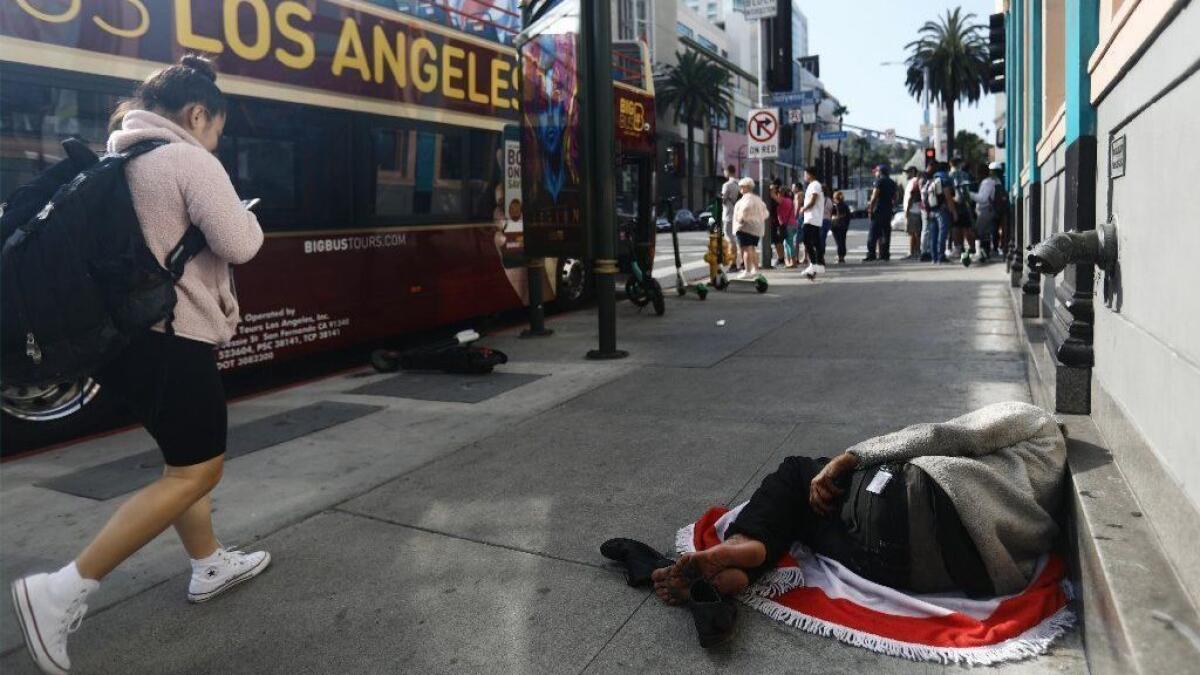Newsletter: Homelessness up, school funding measure down

- Share via
Good morning. I’m Paul Thornton, and it is Saturday, June 8, 2019. Los Angeles has two things going for it now: LAUSD schools are out for the summer, and the Dodgers are really, really good. Read on for the bad.
We’re beginning to get a sense of why Mayor Eric Garcetti probably decided not to run for president (despite spending a conspicuously disproportionate amount of time in Iowa last year): On some of the most basic measures of a city’s health and well-being, Los Angeles is failing spectacularly. Homelessness has skyrocketed. The streets are filthy. Schools are running out of money.
This isn’t to say Garcetti deserves all of the blame, or even much of it. He has no control over the Los Angeles Unified School District, despite brokering an end to the teachers’ strike in January and campaigning for the ill-fated Measure EE, and the intractable homelessness crisis has worsened because of the statewide housing shortage.
But the coincident crises of persistent homelessness and underfunded schools force us to focus our attention on how Los Angeles’ most important institutions have been run (readers have already drawn a connection). On homelessness, the L.A. Times editorial board says the city and county have been doing a lot, but they need to do much more — and quickly:
At the heart of the problem is the desperate housing crisis that continues to plague Los Angeles and California generally. Los Angeles can’t stanch the flow of people into homelessness because housing here has become unaffordable to huge swaths of the population. Since 2000, the median rent in L.A. County has increased 32% while the median renter’s income has fallen 3%, according to the California Housing Partnership Corporation. Evictions, foreclosures, job losses and rent hikes drive people out of their homes, and they can’t find another affordable place to go. There simply is not enough affordable housing for lower-income and very low-income people in the county. (Or in the rest of the state, where homelessness is also climbing. In Riverside and San Bernardino counties, homelessness is up more than 20%. In San Francisco, it’s up 17%. In Alameda County, where Oakland is located, it’s up a staggering 43%.)
California and Los Angeles need to do more to fight homelessness even before it happens. That means supporting more tenant protection measures to hold rents at reasonable levels, stop rent gouging and prohibit unwarranted evictions — in order to keep people in their homes when they are at risk. For legislators across the state to lament the horror of homelessness today even while refusing to pass legislation that protects tenants on the verge of homelessness is irrational and, frankly, unconscionable.
Los Angeles must build more affordable housing for low-income people. If it does not, this will become a city of the affluent and the homeless. Others will be lucky if they can move to communities like Fontana and Chino from which they will spend their mornings and evenings on the freeway commuting into and out of Los Angeles.
Why did Measure EE fail so spectacularly? It’s an off-election year for one, and the older, whiter voters who tend to turn out for those might be less attuned to the needs of LAUSD’s largely poor and minority students. More importantly, says the editorial board, polls show that most voters give the district low marks for performance, so it isn’t surprising they rejected a tax that would have given L.A. Unified $500 million more per year. L.A. Times
Housing crisis? What housing crisis? It’s one thing for state legislators to reject a measure as groundbreaking as Senate Bill 50; it’s another thing entirely for them to water down or outright reject bills meant to give renters some measure of protection. “This is an outrageous abdication of responsibility at a moment when homelessness is getting worse across the state,” says the editorial board. L.A. Times
Gambling nuns — they exist, at least in Torrance. GQ has a riveting account of two sisters from St. James Catholic School in Torrance whose frequent trips to Las Vegas raised a few eyebrows but did not cause too much suspicion of impropriety. But when they retired, an internal review of the school’s finances found the nuns were probably doing a lot more in Sin City than visiting old colleagues and families. GQ
No, sigh, you don’t have to be a white guy to write a magazine cover story. There is so, so much wrong with this statement by Atlantic editor Jeffrey Goldberg: “It’s really, really hard to write a 10,000-word cover story. There are not a lot of journalists in America who can do it. The journalists in America who do it are almost exclusively white males.” Carla Hall’s response: “I wish I could make this blog post response to him 10,000 words long, but, alas, I’m not a white man, so it would be really, really hard for me to do it.” L.A. Times
And you thought you’d get to the end of this newsletter without reading about Trump — and this one’s a doozy. Economist Brad Schiller predicts that if the economic good news continues apace for President Trump, his reelection in 2020 is all but assured. L.A. Times
Reach me: paul.thornton@latimes.com
A cure for the common opinion
Get thought-provoking perspectives with our weekly newsletter.
You may occasionally receive promotional content from the Los Angeles Times.




